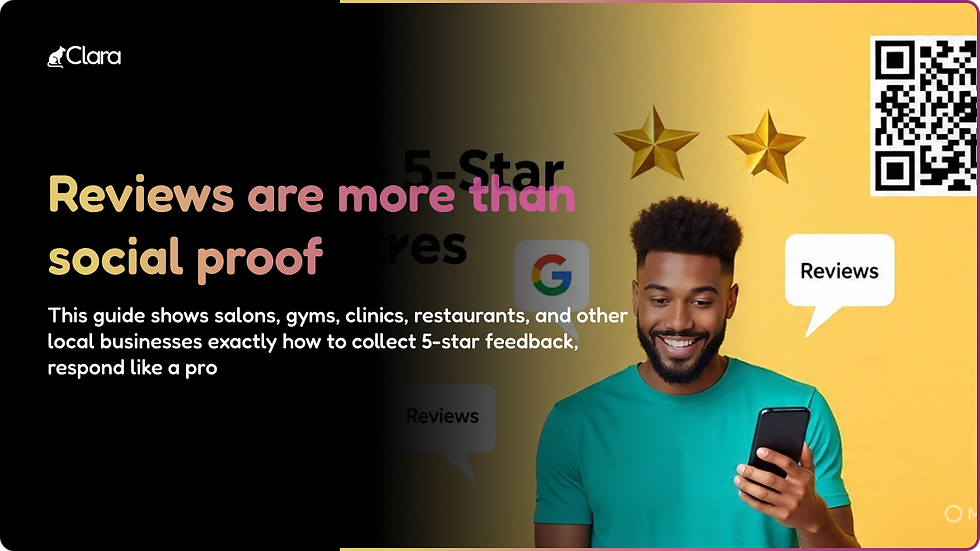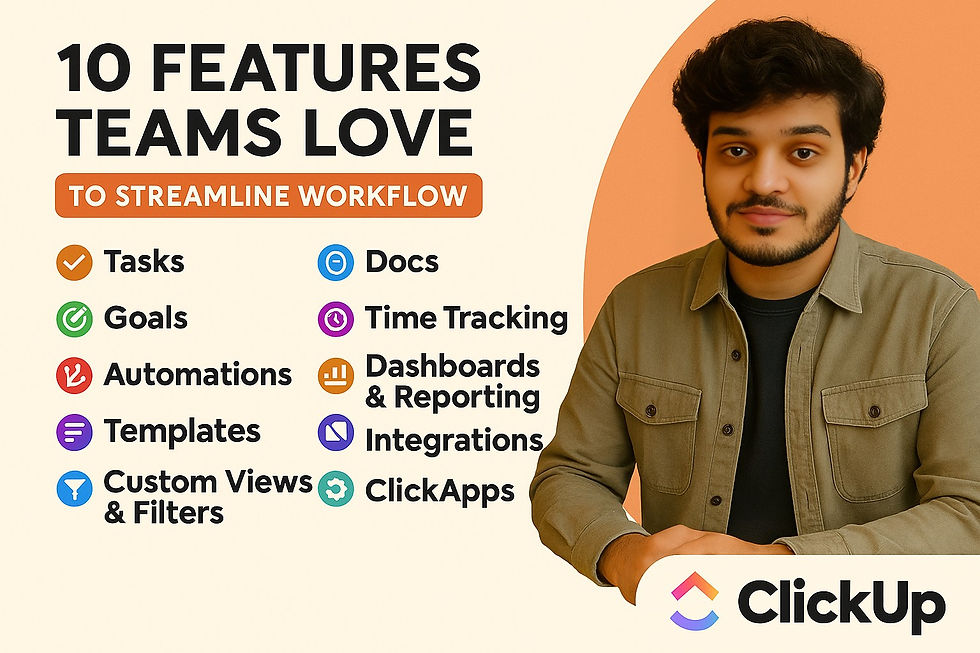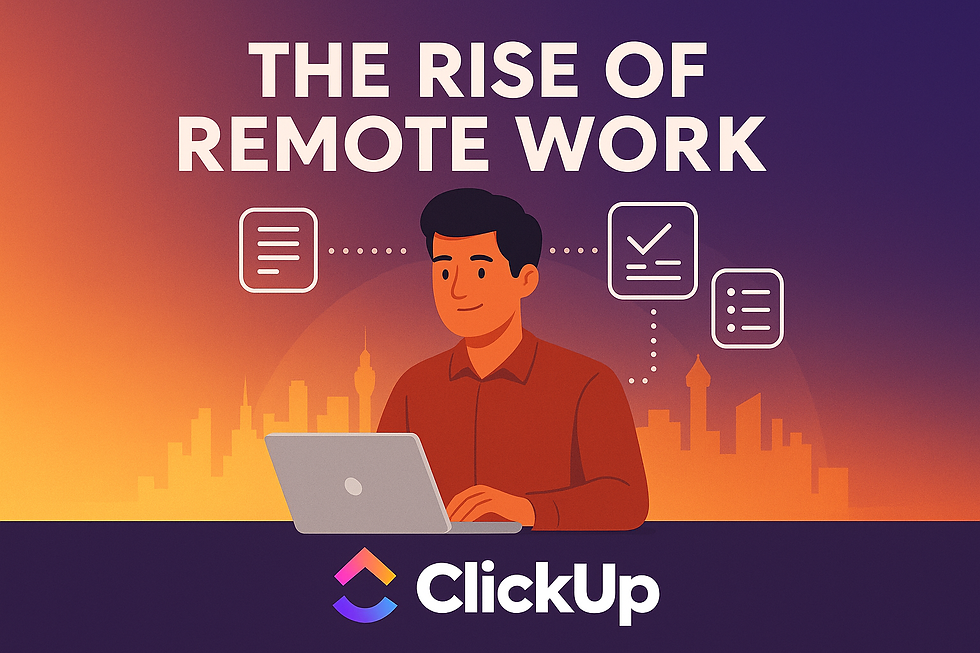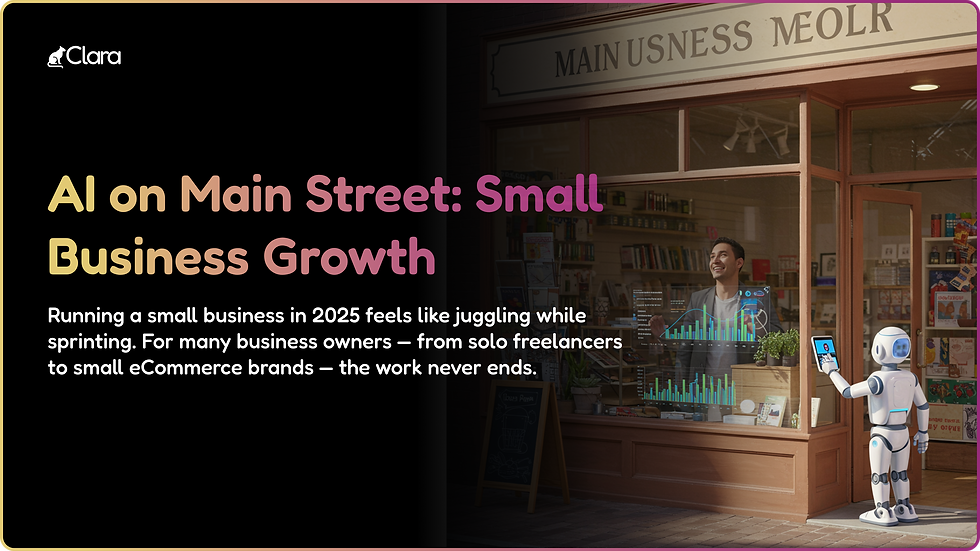- Dravya Bansal
- Jun 15
- 8 min read
Updated: Aug 5
Running a Small Business in 2025: Embracing AI for Growth
Running a small business in 2025 feels like juggling while sprinting. You’re not just selling your service or product — you're also expected to write daily content, reply to customers instantly, keep your website updated, run ads, and somehow sleep. For many business owners — from solo freelancers to small eCommerce brands — the work never ends.
The adoption of Artificial Intelligence is no longer the exclusive domain of tech giants. In 2025, small businesses are increasingly leveraging AI to not only compete but to thrive in the digital marketplace. From hyper-personalized marketing to streamlined operations, AI is proving to be a game-changing asset for online growth. This comprehensive guide explores how small businesses are using AI, the tools at their disposal, the challenges to consider, and a step-by-step plan to get started.
The Role of AI in Small Business Growth
AI is transforming the landscape for small businesses. It offers tools and solutions that can enhance efficiency, improve customer engagement, and drive sales. Understanding how to implement these tools can set a business apart from its competitors.
AI in Marketing
For small businesses, the primary applications of AI in 2025 are centered around three key areas that are crucial for online growth:
Marketing: AI is revolutionizing how small businesses reach and engage with their target audience. By analyzing vast amounts of data, AI algorithms can identify potential customers with unprecedented accuracy. This enables highly targeted advertising campaigns, personalized email marketing sequences that adapt to user behavior, and the creation of content that resonates with specific customer segments. AI-powered tools can also automate social media scheduling, optimize ad spend for maximum return on investment (ROI), and provide deep insights into marketing campaign performance.
Sales: In the sales domain, AI is empowering small businesses to close more deals with greater efficiency. AI-driven CRM (Customer Relationship Management) systems can automatically score leads based on their likelihood to convert, allowing sales teams to prioritize their efforts. AI-powered chatbots can engage with website visitors in real-time, answering questions, qualifying leads, and even scheduling appointments. Furthermore, AI tools can analyze sales data to identify trends, forecast future sales with greater accuracy, and provide sales representatives with real-time insights and talking points during customer interactions.
Customer Service: Exceptional customer service is a key differentiator for small businesses. AI is enabling them to provide 24/7, personalized support without a large support team. AI-powered chatbots and virtual assistants can handle a wide range of customer inquiries, from answering frequently asked questions to tracking orders and processing returns. These AI agents can also analyze customer sentiment to identify and escalate issues before they become major problems. This not only improves customer satisfaction and loyalty but also frees up human agents to focus on more complex and high-value interactions.
Popular AI Tools and Platforms for the Modern Small Business
A burgeoning ecosystem of user-friendly and affordable AI tools is now available to small businesses. Here's a breakdown of popular platforms categorized by their function:
(a) Content Creation and Marketing Automation
Jasper (formerly Jarvis): A leading AI writing assistant that can generate a wide variety of content, including blog posts, social media updates, website copy, and email newsletters.
Copy.ai Another popular AI-powered copywriter that helps businesses create engaging marketing copy in various tones and styles.
Canva AI: Integrated within the popular design platform, Canva's AI features can help generate design ideas, write copy for visuals, and even create presentations.
HubSpot Marketing Hub: Offers a suite of AI-powered tools for marketing automation, including email marketing, lead nurturing, and social media management.
Mailchimp: Incorporates AI to help small businesses optimize email campaign performance through smart recommendations for send times, audience segmentation, and content.
(b) Customer Support and Engagement (Chatbots)
Tidio: A user-friendly platform that combines live chat and AI chatbots to engage with website visitors and provide instant support.
ManyChat: A popular choice for creating AI-powered chatbots for Facebook Messenger, Instagram, and SMS to automate conversations and marketing.
Drift: A conversational marketing and sales platform that uses AI chatbots to qualify leads and connect them with sales representatives in real-time.
Intercom: Offers a comprehensive customer communications platform with AI-powered chatbots, live chat, and automated messaging.
(c) E-commerce Optimization
Shopify Magic: A suite of AI-powered features within the Shopify platform that helps with product descriptions, email marketing, and store customization.
Personizely: An AI-powered personalization platform that allows e-commerce businesses to display dynamic content, product recommendations, and personalized offers.
Dynamic Yield by Mastercard: A more advanced platform that provides AI-driven personalization, A/B testing, and dynamic pricing for e-commerce stores.
Clearbit: While primarily a data enrichment tool, it can be used to personalize the e-commerce experience by providing deeper insights into website visitors.
(d) Data Analysis for Customer Behavior and Sales Forecasting
Google Analytics 4 (GA4): Leverages machine learning to provide deeper insights into user behavior, predict future actions, and identify trends.
Tableau: A powerful data visualization tool that can be used to analyze customer data from various sources and create interactive dashboards.
Microsoft Power BI: A business analytics service that provides interactive visualizations and business intelligence capabilities with an easy-to-use interface.
Airtable: While a versatile database tool, its new AI features allow for the analysis and summarization of data, making it useful for tracking customer behavior and sales trends.
AI in Action: Small Business Success Stories
While large corporations often dominate the AI headlines, numerous small businesses are achieving remarkable results.
Case Study: A Boutique Online Retailer and AI-Powered Personalization
A small online clothing boutique was struggling to compete with larger fashion retailers. They implemented an AI-powered product recommendation engine on their e-commerce site.
Challenge: Limited marketing budget and difficulty in showcasing their diverse product range to the right customers.
AI Solution: An AI tool that analyzed customer browse history, purchase data, and real-time behavior to provide personalized product recommendations on the homepage, product pages, and in email marketing.
Measurable Results: Within six months, they saw a 25% increase in average order value and a 15% increase in their conversion rate. Customer feedback also highlighted a more enjoyable and personalized shopping experience.
Case Study: A Local Service Business and the Power of AI Chatbots
A local plumbing company was missing out on potential leads because they couldn't answer the phone 24/7.
Challenge: Limited administrative staff to handle after-hours inquiries and appointment scheduling.
AI Solution: They integrated an AI-powered chatbot on their website and Facebook page. The chatbot could answer common questions, provide quotes for standard services, and schedule appointments directly into their calendar.
Measurable Results: They reported a 30% increase in qualified leads within the first three months. The chatbot handled over 60% of initial customer interactions, freeing up the owner to focus on service delivery and business growth.
Navigating the AI Landscape: Challenges, Risks, and Ethical Considerations
Adopting AI is not without its hurdles. Small businesses need to be aware of the following:
Data Privacy: AI systems often require large amounts of data to function effectively. Small businesses must ensure they are collecting, storing, and using customer data ethically and in compliance with regulations like GDPR and CCPA. Transparency with customers about how their data is being used is crucial.
Implementation Costs: While many AI tools are becoming more affordable, the initial investment in software, training, and potential integration can still be a barrier for some small businesses. It's essential to start with a clear budget and focus on AI solutions with a high potential for ROI.
Potential for Bias: AI algorithms are only as good as the data they are trained on. If the training data contains biases, the AI's outputs will also be biased. This can lead to unfair or discriminatory outcomes in areas like marketing and hiring. Small businesses should be mindful of this and strive to use diverse and representative data.
The Need for Human Oversight: AI should be seen as a tool to augment human capabilities, not replace them entirely. It's crucial to have humans in the loop to monitor AI systems, handle complex situations that require empathy and nuanced understanding, and ensure that the technology aligns with the company's values.
Job Displacement Concerns: While AI can automate certain tasks, the focus should be on how it can free up employees to engage in more creative, strategic, and customer-facing activities. Open communication with employees about the role of AI in the business is essential to address any fears of job displacement.
Your Step-by-Step Guide to AI Implementation
For a small business owner ready to embrace AI, here's a practical, five-step guide:
Identify Your Biggest Challenges and Opportunities: Before diving into specific tools, analyze your business operations. Where are the biggest bottlenecks? What repetitive tasks consume the most time? Where could you make the most significant impact on growth? For example, is it lead generation, customer support response times, or content creation?
Start Small and Focus on High-Impact Areas: Don't try to implement AI across your entire business at once. Choose one or two key areas identified in the first step. For instance, if customer service is a pain point, start with a simple chatbot. If marketing is the priority, experiment with an AI content creation tool.
Research and Select the Right Tools for Your Needs and Budget: Based on your chosen focus area, research the available AI tools. Look for platforms that are designed for small businesses, offer free trials or affordable subscription plans, and have a reputation for ease of use and good customer support. Read reviews and compare features before making a decision.
Implement and Integrate Thoughtfully: Once you've selected a tool, take the time to implement it correctly. This may involve some initial setup and training. Ensure it integrates smoothly with your existing systems (e.g., your website, CRM, or social media platforms).
Measure, Learn, and Iterate: The key to successful AI adoption is continuous improvement. Track the performance of your new AI tools. Are you seeing the desired results? Gather feedback from your team and customers. Be prepared to make adjustments and iterate on your approach as you learn what works best for your business.
The Future of AI for Small Business: Beyond 2025
Looking ahead, several emerging AI trends are set to further empower small businesses:
Hyper-Automation: We will see a move beyond task automation to the automation of entire workflows. AI will be able to connect different applications and make decisions with minimal human intervention, streamlining everything from inventory management to financial reporting.
The Rise of AI Agents: AI will evolve from tools that we use to autonomous agents that we delegate tasks to. Imagine an AI agent that can not only schedule your social media posts but also analyze their performance, identify trending topics, and generate new content ideas, all on its own.
Democratization of Advanced AI: More sophisticated AI capabilities, such as advanced data analysis and predictive modeling, will become accessible and affordable for even the smallest businesses through user-friendly, no-code platforms.
AI-Powered Creativity: Generative AI will continue to advance, enabling small businesses to create high-quality marketing materials, videos, and even product prototypes with ease, leveling the playing field with larger competitors.
Ethical AI as a Brand Differentiator: As consumers become more aware of AI's societal impact, businesses that prioritize ethical AI practices, data privacy, and transparency will build stronger brand trust and loyalty.
Supercharge Your AI Journey: Exclusive Resources for Our Newsletter Subscribers
To thank you for subscribing to our newsletter, we're offering these exclusive, downloadable resources to help you kickstart your AI adoption:
Deliverable 1: The Ultimate AI Tool Checklist for Small Businesses: A curated and categorized list of the top AI tools for marketing, sales, customer service, and e-commerce, complete with pricing tiers and key features to help you make informed decisions.
Deliverable 2: Your "Getting Started with AI" Exclusive Guide: A practical, step-by-step workbook that walks you through the process of identifying your business needs, selecting the right AI tools, and creating a simple implementation plan. This guide includes templates and actionable tips to ensure a smooth and successful AI journey.
By embracing the power of Artificial Intelligence, small businesses can unlock unprecedented opportunities for growth, innovation, and customer connection. The future is intelligent, and for the savvy small business owner, it's a future filled with promise.



















